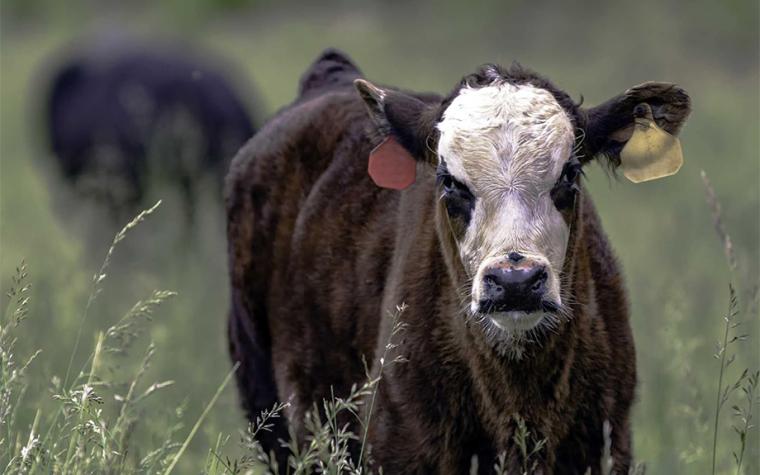COLUMBIA, Mo. – These are interesting times in the beef industry, says University of Missouri Extension state beef nutritionist Eric Bailey.
Cattle prices are higher than ever, yet there is scant evidence of herd expansion in the macroeconomic data. However, enormous asking prices exist for bred heifers marketed online, Bailey says.
Before you head to the sale barn, Bailey suggests a review of data that shows that early-calving bred heifers pay off many times over.
Older, earlier-calving heifers have an advantage over the long run
A 2013 Journal of Animal Science article, Heifer Calving Date Positively Influences Calf Weaning Weights Through Six Parturitions (doi: 10.2527/jas.2013-6465), is “truly impactful science” that supports the argument that older, early-calving heifers offer an advantage in the long run, says Bailey.
Datasets evaluated in the manuscript include production records from the U.S. Meat Animal Research Center and the South Dakota Integrated Resource Management Groups. First-calf heifers that calved in the first 21 days of the calving season were one year older (5 years old) when diagnosed open compared to heifers that calved (4 years old) after the first 21 days of the calving season.
“Imagine getting an extra calf out of a cow just because she calved early the first time,” Bailey says. “Furthermore, heifers that calved early as first-calf heifers weaned a heavier calf not just the first year but all the way out through the sixth calf compared to heifers that calved after the first 21 days.”
The difference was approximately 50 pounds in the first year and 15 pounds in the sixth calf. Based on this data, Bailey estimates that the earlier-calving heifer produced an additional 150 pounds of weaned calf over a six-year period.
“At today’s prices, there is a substantial economic advantage to buying an earlier-calving heifer,” he says.
Why does this happen and how do we take advantage of this?
A beef cow is pregnant for approximately 285 days. When a farm imposes defined calving seasons, cows that have long postpartum intervals between calving and breeding calve later each year until slipping outside of the breeding season.
It is rare for a cow to calve earlier next year than this year. Postpartum interval is generally at least six weeks, and the estrous cycle in beef cattle is 21 days. To calve on the same date each year, a beef cow must become pregnant within about 85 days of calving. If her postpartum interval is 42 days, then she has roughly two estrous cycles to become pregnant.
Body condition plays an important role in this. Body condition score at calving has proven to be a strong predictor of the length of the postpartum interval. At calving, beef cows need to be at least 5 on a 1-9 scale, and heifers need to be a 6.
Age is the strongest predictor of weaning weight for beef calves. “Having a lot of cows get pregnant early in the breeding season will do wonders for the weaning weight of your calf crop,” says Bailey. “Reproductive management tools like estrus synchronization and artificial insemination can help get a bunch of cows and heifers pregnant early in the breeding season.” It is important to have them in adequate body condition and gaining weight to breed early.
How do I use the information from this article to make bred heifer buying decisions this fall?
Bailey favors heifers that are bred to artificial insemination, based upon data from the article. “I’ll have a tight estimate of calving date and the ability to select heifers bred to calve early in my calving season,” he says. “I would even consider heifers bred to calve 30 days earlier than my mature cow breeding season to give first-calf heifers an additional chance in their second breeding season. I’m willing to pay more for this certainty. How much more is debatable.”
From the U.S. Meat Animal Research Center dataset, it appears that the early-calving heifer produced about 150 pounds additional weaned calf over heifers that calve later. Right now, the market value of gain (NOT sale price) says that the value of gain in the 400–600-pound range is about $3 per pound.
Of course, that’s just a snapshot of the current market, says Bailey.
“Buyers should factor in that market dynamics could, and will, change dramatically in the next six years, which is what we would be projecting out,” he says.
Bailey uses a concept called “net present value” to make this decision. The net present value of $450 (revenue from the additional 150 pounds of weaning weight) delivered over the next six years at an 8% discount rate is $346.72. He says he would be willing to pay an additional $200-$300 for a heifer bred to artificial insemination over one bred via natural service using today’s market prices.
“The sticker shock of bred heifer prices may make it difficult to raise your hand at auctions this fall, but there is data available to help make more informed decisions,” says Bailey.
